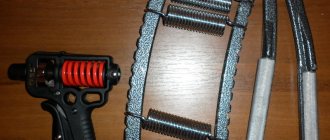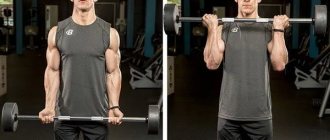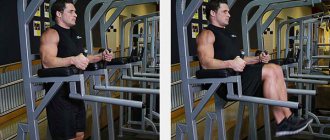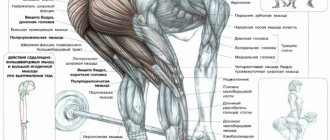Rules for performing the exercise
- Lie on the floor with your feet immobilized or have a partner hold them. Legs are bent at the knees.
- Place your hands behind your head, clasping your fingers at the back of your head. This is the starting position.
- As you exhale, lift your upper torso so that your body assumes a V-shape position.
- Hold for a second and inhale as you return to the starting position.
- Repeat as many times as necessary.
Variations: To make it more difficult, you can work with additional weight, holding it with crossed arms at chest level.
Short description
Lie down on the floor. Legs are bent at the knees. Place your hands behind your head, clasping your fingers at the back of your head. As you exhale, lift your upper body about 45 degrees. As you inhale, return to the starting position.
Body lifting technique
From the starting position, inhaling deeply, exhaling, lift the body of the body EXCLUSIVELY WITH THE STRENGTH OF THE ABDOMINAL MUSCLES, not reaching a little to a vertical position (angle of about 70 degrees), maintaining muscle contraction of the abs.
At the top point, we relax the press, and additionally shorten it, making a second delay, inhaling, lower the torso to the floor until your shoulder blades touch and immediately go up again. We rise without swinging and pushing off the floor with our backs.
Until the end of the exercise, do not touch the floor with your shoulders; the abs are tense from the beginning to the end of the exercise.
What muscles work
This complex can be performed by both fragile women and courageous representatives of the stronger half of humanity. The main requirement is constant training, performing the required number of times. Only in this case will it be possible to achieve the desired result over time. It's worth starting with the classic form.
The effect of the exercises can be felt within two to four weeks. When performing, all the muscles of the anterior abdominal wall are involved, especially the upper part. The main load falls on the rectus abdominal wall muscle, in particular on its upper part.
A static load is placed on the group of oblique abdominal muscles and spinal column extensors. Thanks to this, the stomach becomes toned, strong, and flat. The muscle corset is strengthened.
Fitness trainers say that workouts that involve performing exercises at high speed are considered more productive.
How often to pump your abs
In theory, the abdominal muscles are very resilient and therefore recover quickly after strength training. It is believed that a day is enough for the press to “move away” from the previous load. This is why in bodybuilding daily abdominal training was previously considered the norm.
Over time, many practical observations have accumulated about the optimal frequency of pumping the rectus abdominis muscles.
If we are talking about increasing the thickness of the abdominal muscles, that is, so that the abs become as convex as possible, then abdominal training in a traditional strength mode is suitable.
Performing one or two exercises, 2-3 times a week, is the standard for the bulking period. It is necessary to use additional weights - a disc from a barbell or a dumbbell in your hands.
When training for relief, the abs are pumped in a high-repetition mode. That is, they are working on his endurance and tone.
The appropriate frequency of exercise in this case is 3-4 times a week . Although many athletes also practice six abdominal workouts in a weekly cycle.
Why, when and how many times to do the exercise
Why pump up your abs? There are several reasons why you definitely need to pump up your abs:
| Beautiful, straight posture | Strong, toned muscles support the body in the correct position. The elastic muscle corset of the anterior abdominal wall maintains an even posture in any body position. |
| The functioning of internal organs and systems improves | During exercise, there is a rush of blood and oxygen to all cells and tissues. However, there is an important condition - compliance with breathing techniques. Lifting is done with exhalation |
| Psychological factor | A beautiful, toned abs will give men confidence, and a thin, flexible waist is always an adornment and asset to a woman’s figure |
| Slenderness | With regular training, sit-up strengthens and tightens muscles. This is not only the consumption of calories and the breakdown of fats, but also the prevention of stretching of the gastric walls. It curbs excessive food consumption |
| Helping a woman during childbirth | Women who constantly train and perform exercises according to all the rules find it much easier and faster to give birth to a baby. |
The regularity of training depends on the physical fitness of the person. Those who are not new to sports, who regularly jog and visit the gym, are recommended to perform classes according to the following scheme: 2 days of training alternate with one day of rest.
If a person is just starting to train and play sports, it’s worth starting with two workouts a week. A prerequisite is the availability of days off. This is necessary for complete muscle recovery after exercise.
The best option is to perform sipaps closer to the end of the workout.
How many times should you train your abs?
The optimal number of lifts is 30, that is, three sets of ten times. It's better to start at ten. Over time, you can gradually increase the number of times and complicate the technique. Before actually performing the exercise itself, it is worth doing a warm-up.
Options for lifting your torso
The most common version of the sitap is the classic one. It can be performed at home.
Classic body lift on the floor
Beginners are advised not to rush or make sudden movements.
- Take an emphasis lying on the floor face up.
- Bend the lower limbs at the knee joint.
- Place your feet on the floor. If necessary, support yourself against a heavy object, dumbbells or barbell.
- Close your hands at the back of your head.
- Raise the body as you exhale so that the body takes the shape of the letter V. The back remains straight, the feet are firmly adjacent to the floor surface.
- In a sitting position, you can touch your feet with your fingers.
- Return to the starting position while inhaling.
Option 1 - simpler
Place your arms crosswise on your chest. This allows you to relieve the spine during movement.
- The initial position corresponds to that in a simple classical sitap.
- Lifting the body is performed while exhaling.
- While inhaling, return to the starting position.
The optimal number of repetitions is 30, three times ten.
Option 2 - more complicated, with body rotation
With a cross-shaped rise. There are two options for lifting the body in this version. Both options are similar to the classic version, but each of them has its own distinctive features.
As a result of lifting the body, try to touch the opposite knee with your elbow. The arms are either folded crosswise on the chest or clasped at the back of the head.
Another execution option involves lifting the body and alternately touching the opposite knee with the elbow as it lifts.
Option 3 - as safe as possible for the lower back
To minimize the load on the lumbar spine, you need to perform the movement according to the classic pattern with your arms crossed over your chest. It is also necessary to place a bolster under the lumbar spine, or raise the lower limbs 90 degrees.
Thanks to the roller, the possibility of pinching nerve endings and blood vessels is eliminated.
With weights. Lie down on the floor. Knees bent. Hold the weight with both hands near your chest. Begin to lift your back off the floor and lift your torso. At the top of the movement, raise your arms with the disc above your head. As you move down, lower the weight back toward your chest.
Lifting from a lying position (Sitap) with a disc
How to fix it
Replace sit-ups with crunches or planks
Instead of sit-ups, do crunches without lifting your lower back off the floor. This will protect the spine from injury and will strengthen the rectus abdominis muscles.
However, crunches also have their own dangers. This time we are talking about tension in the cervical spine. Some beginners lean their neck forward too much. Repeated repetitions of this exercise plus working at a computer with constant tension in the cervical spine - and training can result in pain. But there is a way out.
When performing crunches, try to keep your neck relaxed and do not pull your chin towards your chest.
You can also replace sit-ups with planks or pulling your knees to your chest while hanging on a horizontal bar.
Perform body lifts slowly
If you slow down the repetition too much, you simply won’t be able to pull yourself through the hip flexors. In addition, slow sit-ups are a great option for working your abs. This way it will tense up much more than during fast or sudden movements.
An interesting variation of this exercise is a slow twist with your arms above your head and your legs straight. Lie on your back, straighten your legs, extend your arms above your head and begin to twist, lifting your body. The goal is to complete the exercise as slowly as possible. After straightening, begin to lower yourself very slowly and, if possible, linger at the point where your muscles feel the greatest tension.
That's all. Do the exercises correctly and you will protect yourself from injury in the gym and during home workouts.
Options for doing it in the gym
The technique of performing a sit-up in the gym involves the use of special sports equipment, attributes, and exercise equipment for better muscle development. Most commonly, the Roman chair and incline bench technique is used.
On a Roman chair
- Sit on the seat of a chair.
- Choose the optimal distance from the seat to the legs - bolsters in the ankle area.
- Legs straight, feet behind the rollers.
- The hands are folded on the chest or closed at the back of the head.
- As you exhale, the body lowers down until it reaches the level of the shins.
- As you inhale, smoothly raise your body to the starting point.
- Repeat as many times as necessary.
This variation of execution does not involve the use of weights, especially at the initial stage due to the high range of motion.
On an incline bench (with or without weights)
Lie on an incline bench at the desired incline. Secure your feet to the bolsters. Grasp the barbell disc with your hands. As you exhale, lift your body perpendicular to the floor. As you inhale, lower yourself to the starting position.
Lifting on an inclined bench (Sitap) with a load
Different angles and load severity
The higher the angle of the bench, the higher the load on the muscle frame. As the angle of inclination increases, the load on the spine decreases. The smallest inclination is 15 degrees. If the angle of inclination is from 40 to 60 degrees, performing a situp is considered especially difficult and does not require additional weighting in the form of dumbbells or pancakes.
When choosing the severity of the load and the angle of inclination, it is necessary to take into account the level of physical fitness and age category. Lifting the body with the head end down can provoke dizziness, changes in blood pressure, and tinnitus. The optimal tilt angle is 30 degrees. Let's consider several versions:
On an incline bench with rubber. Secure a resistance band around an incline bench. Lie down and grasp the handles with your palms facing forward. Pull them up near your collarbones and turn your wrists with your palms facing your torso. As you exhale, lift your body perpendicular to the floor. As you inhale, lower yourself to the starting position.
Raising the torso on an inclined bench (Sitap) with an expander
Oblique situps on an incline bench. Lie down on an incline bench. Place one hand on the back of your head, the other on your thigh. As you exhale, twist, turning your body to the left until your right elbow touches your left knee. Repeat as many times as necessary and switch sides.
Oblique crunches on an incline bench (sitap)
Press while lifting the body from a lying position (sitap). Lie on an ab bench, holding a barbell to your chest. Tighten your abdominal and buttock muscles. As you exhale, do a regular abdominal crunch and at the same time press the barbell overhead. As you inhale, lower your upper body and the barbell back to the starting position.
Bench press from a lying position (sitap)
How can you replace sitaps?
Many exercises in the base on the abdominal muscles will allow you to replace sit-ups. Here are just a few of them.
Vacuum of the abdominal cavity. A simple and accessible alternative to everyone is a vacuum. It can be performed at home, at work, while walking, while driving, etc. You can make a vacuum in any position of the body. You need to exhale, pull your stomach in, feel your abdominal muscles, and stay in this position for 20 seconds.
Then relax, breathe in air and repeat the exercise several more times.
Abdominal vacuum
Fitness instructors also recommend several unusual movements that can replace sit-ups:
Body lifts using the Janda method. Lie on the floor, bend your knees at an angle of 90 degrees, feet on the floor, arms crossed over your chest. As you exhale, tightening your buttocks and hamstrings, slowly lift your body. As you inhale, return to the starting position.
Body lifts using the Janda method
Throwing a ball with both hands while lying on the floor. Lie down on the floor. Legs are bent at the knees. Hold the ball at arm's length behind your head. Throw the ball forward from the shoulder, while simultaneously taking a sitting position. Have a partner catch the ball and throw it back to you, or it can bounce off the wall.
Throwing a ball with both hands while lying on the floor
Limb raises for those who are trained
Raises legs to arms. It is especially valued among experienced athletes as it simultaneously loads the upper and lower abdominals.
- lie on your back;
- stretch your legs and arms;
- Exhaling air, rise slightly and raise your limbs. The arms are raised parallel to the legs, the torso does not touch the ground, the lifting angle is 35-45 degrees;
- Exhale and lie down on the floor again. The load is focused on all muscle groups of the anterior abdominal wall.
Raising legs to arms from a lying position
Leg raises to the chest on a straight bench. Sit on a bench, straighten your legs, and hold onto its surface with your hands. Bend over slightly and then pull your knees towards you while lifting your torso. After a second pause, return to the starting position and repeat the exercise.
Leg raises to chest on a straight bench
What do we do after completing the exercise?
After a good workout, you need to stretch. The muscles are warmed up, so it's good to stretch.
There are also stretching exercises for the abs: lifting the body from a lying position on your stomach. With its help, the back extensor muscles are well trained.
How to do this exercise? First you need to lie on your stomach. The face looks at the floor, the arms are located along the body, the legs are spread shoulder-width apart. As you exhale, we lift the shoulder girdle, hold for a few seconds and gradually lower. To increase the difficulty, you need to simultaneously raise your arms and legs with your body, as high as you can do it. All movements must be smooth and controlled.
For such training, no additional equipment is needed; you can do these exercises anywhere: on vacation, at home or outside in the warm season. Even if you do not have the opportunity to attend a training session at a fitness club, this is not a reason to skip classes. You can train in any conditions for the benefit of your health and your figure, adhering to the correct technique.
We really believe that our advice and workouts, which are on our website, will help you transform and achieve the body of your dreams. Incorporate the sit-up exercise into your workout routine and your abs will definitely become flatter.
I wish you success!
What to pay attention to
When performing movements, you need to pay attention to the following nuances:
- The back should always be straight.
- You should not exercise immediately after eating.
- While lifting the body, the feet are pressed tightly to the floor surface.
- If the rollers from exercise machines leave marks on the body, use foam inserts.
- Raising the body from the initial position - a lying position - is performed while exhaling. Return to the starting position while inhaling.
- During the lift, the head should be on the same plane as the back. Tilts and turns are excluded.
- The load is added gradually. Starting with complicated versions of sitap can lead to health problems and lower back injuries.
Alternative Exercises











